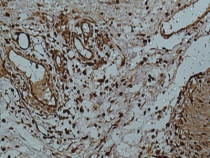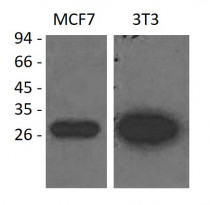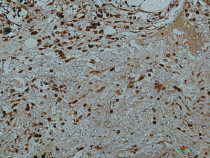ARG66239
anti-Galectin 3 antibody
anti-Galectin 3 antibody for IHC-Frozen sections,IHC-Formalin-fixed paraffin-embedded sections,Western blot and Human,Mouse
Overview
| Product Description | Mouse Monoclonal antibody recognizes Galectin 3 |
|---|---|
| Tested Reactivity | Hu, Ms |
| Tested Application | IHC-Fr, IHC-P, WB |
| Host | Mouse |
| Clonality | Monoclonal |
| Target Name | Galectin 3 |
| Antigen Species | Human |
| Immunogen | Recombinant protein of Human Galectin-3. |
| Conjugation | Un-conjugated |
| Alternate Names | Laminin-binding protein; Gal-3; L-31; GALBP; Galactoside-binding protein; MAC2; GAL3; GALIG; Mac-2 antigen; CBP 35; Galectin-3; CBP35; Galactose-specific lectin 3; IgE-binding protein; L31; 35 kDa lectin; Carbohydrate-binding protein 35; Lectin L-29 |
Application Instructions
| Application Suggestion |
|
||||||||
|---|---|---|---|---|---|---|---|---|---|
| Application Note | * The dilutions indicate recommended starting dilutions and the optimal dilutions or concentrations should be determined by the scientist. | ||||||||
| Observed Size | 26 kDa |
Properties
| Form | Liquid |
|---|---|
| Purification | Affinity purification with immunogen. |
| Buffer | PBS, 0.02% Sodium azide, 50% Glycerol and 0.5% BSA. |
| Preservative | 0.02% Sodium azide |
| Stabilizer | 50% Glycerol and 0.5% BSA |
| Concentration | 1 mg/ml |
| Storage Instruction | For continuous use, store undiluted antibody at 2-8°C for up to a week. For long-term storage, aliquot and store at -20°C. Storage in frost free freezers is not recommended. Avoid repeated freeze/thaw cycles. Suggest spin the vial prior to opening. The antibody solution should be gently mixed before use. |
| Note | For laboratory research only, not for drug, diagnostic or other use. |
Bioinformation
| Database Links | |
|---|---|
| Gene Symbol | LGALS3 |
| Gene Full Name | lectin, galactoside-binding, soluble, 3 |
| Background | This gene encodes a member of the galectin family of carbohydrate binding proteins. Members of this protein family have an affinity for beta-galactosides. The encoded protein is characterized by an N-terminal proline-rich tandem repeat domain and a single C-terminal carbohydrate recognition domain. This protein can self-associate through the N-terminal domain allowing it to bind to multivalent saccharide ligands. This protein localizes to the extracellular matrix, the cytoplasm and the nucleus. This protein plays a role in numerous cellular functions including apoptosis, innate immunity, cell adhesion and T-cell regulation. The protein exhibits antimicrobial activity against bacteria and fungi. Alternate splicing results in multiple transcript variants.[provided by RefSeq, Oct 2014] |
| Function | Galactose-specific lectin which binds IgE. May mediate with the alpha-3, beta-1 integrin the stimulation by CSPG4 of endothelial cells migration. Together with DMBT1, required for terminal differentiation of columnar epithelial cells during early embryogenesis (By similarity). In the nucleus: acts as a pre-mRNA splicing factor. Involved in acute inflammatory responses including neutrophil activation and adhesion, chemoattraction of monocytes macrophages, opsonization of apoptotic neutrophils, and activation of mast cells. [UniProt] |
| Calculated MW | 26 kDa |
Images (4) Click the Picture to Zoom In
-
ARG66239 anti-Galectin 3 antibody IHC-Fr image
Immunohistochemistry: Mouse intima-media wall stained with ARG66239 anti-Galectin 3 antibody at 1:200 dilution.
From Rui Fan et al. Biochim Biophys Acta Mol Cell Biol Lipids. (2023), doi: 10.1016/j.bbalip.2023.159330, Fig. 2B.
-
ARG66239 anti-Galectin 3 antibody IHC-P image
Immunohistochemistry: Paraffin-embedded Human colon tissue stained with ARG66239 anti-Galectin 3 antibody at 1:50 dilution.
-
ARG66239 anti-Galectin 3 antibody WB image
Western blot: MCF7 and 3T3 cell lysates stained with ARG66239 anti-Galectin 3 antibody at 1:2000 dilution.
-
ARG66239 anti-Galectin 3 antibody IHC-P image
Immunohistochemistry: Paraffin-embedded Human colon tissue stained with ARG66239 anti-Galectin 3 antibody at 1:50 dilution.
Specific References











